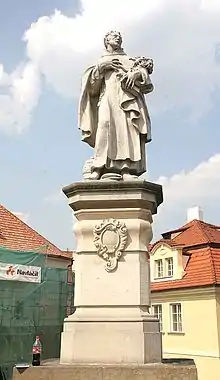Philip Benizi de Damiani
Philip Benizi (sometimes St Philip Benitius, and in Italian Filippo Benizzi) (August 15, 1233 – August 22, 1285) was a general superior of the Order of the Servites, and credited with reviving the order. Pope Leo X recognised his cult 24 January 1516 essentially beatifying him (although this was not a formal category at the time); and Pope Clement X canonized him as a saint in 1671.
Saint Philip Benizi | |
|---|---|
 | |
| Confessor | |
| Born | August 15, 1233 Florence, Republic of Florence (modern-day Italy) |
| Died | August 22, 1285 (aged 52) Todi, Papal States (modern-day Italy) |
| Venerated in | Roman Catholic Church |
| Canonized | April 12, 1671, Rome by Pope Clement X |
| Major shrine | Church of the Servites of Mary in Todi, Umbria, Italy |
| Feast | August 23 |
| Attributes | Habit of the Servite Order, Lily, book, papal tiara |
| Patronage | Minor Basilica of Monte Senario (Vaglia) in the Diocese of Florence, Tuscany, Italy; Zamboanga del Norte, Philippines |
Biography
According to his later legende, Philip Benizi was born on August 15 in the Florentine district of Oltrarno, the day the Blessed Virgin first appeared to the Seven Founders. He became the great propagator of the Order of the Servants of Mary (the Servites). When he was elected the general superior on June 5, 1267, the order, which had long been the object of attack from enemies, entered into the crisis of its existence. The Second Council of Lyons in 1274 put into execution the ordinance of the Fourth Lateran Council, forbidding the foundation of new religious orders, and absolutely suppressing all mendicant institutions not yet approved by the Holy See. In 1276 Pope Innocent V, in a letter addressed to Philip, declared the order suppressed. Philip then proceeded to Rome, but before his arrival there, Innocent V had died.[1]
The city of Forlì was part of the Papal States and, in 1283, the site of strong anti-papal sentiment was placed under interdict. Pope Martin V asked Philip to go to Forlì and try to reconcile the divided city. According to certain sixteenth century legende of Philip Benizi the eighteen-year-old Peregrine Laziosi (Latiosi), the son of a Ghibelline leader, was among those abusive towards Philip. However Philip's meeting with the initially antagonistic Peregrine help the young man later decide to join the Servite order. Saint Peregrine was canonized by Pope Benedict XIII in 1726.[2] According to Peregrine's earliest legenda, this meeting between Philip and Peregrine never happened.
Philip died on August 22, 1285, during the Octave of the Assumption at Todi, where he is buried.[3]
In the cloister of Santa Maria of the Servites in Vicenza, took place his miracles in 1319.[4]
Veneration
The Church of the Servites of Mary in Todi, Umbria, contains the body of St Philip Benizi, whose statue is the work of Bernini.
St Philip's feast day is celebrated on August 23. He and Santa Maria Addolorata are the titular co-patrons of the minor basilica of Monte Senario (in Vaglia, Metropolitan City of Florence), in the Diocese of Florence (since 1917).
Churches named in honor of St Philip Benizi
- In Jonesboro, GA, United States, a Catholic church named after St Philip Benizi was erected by the Archdiocese of Atlanta, Georgia in 1965.[5]
- St Philip Benizi Roman Catholic Church, Chicago, Illinois (Archdiocese of Chicago).
- St Philip Benizi Catholic Church, Fullerton, California.
- St Philip Benizi Catholic Church, Oregon City, Oregon.
- St. Philip Benizi Catholic Church, Creswell, Oregon. (Archdiocese of Portland in Oregon.)
- St. Philip Benizi Catholic Church, Viburnum, Missouri.
- St. Philip Benizi Catholic Church, Moncks Corner, South Carolina.
- St. Philip Benizi Catholic Church, Poteet, Texas.
- St. Philip's Priory, Chelmsford, England - a priory of the Premonstratensian Order.
- Our Lady of Sorrows and St. Philip Benizi Catholic Church, Fordingbridge, Hampshire, England.
- St. Philip Benizi Mission, Black Canyon City, Arizona.
- St. Philip Benizi Parish, Diocese of Dipolog, Philippines
- St Phillip Benizi Roman Catholic Church, Grafton, Massachusetts, United States
- St Philip Benizi Catholic Church, Ford, WA, United States

St. Philip Benizi, Belle Glade, Florida, USA
Cultural references
Five scenes from his life were painted in the early 16th century by the Florentine Andrea del Sarto: "His Charity to a Leper", "The Smiting of the Blasphemers", "The Cure of the Woman Possessed with a Devil", "The Resurrection of a Child before the bier of the Saint", and "The Veneration of his Relics". These appear in the atrium of the Servite church of the SS. Annunziata, Florence.
There is a statue of him on the Charles Bridge in Prague, Czech Republic. Designed in 1714, this statue was made from Salzburg marble and donated by the Servites convent in Prague. The statue portrays him holding a cross, a book and a spray. By his legs there is the crown of the pope. A clay model of this statue can be found in the Salzburg museum.
There is also a chapel dedicated to him in the church of San Marcello al Corso in Rome, and a statue dedicated to him at The National Sanctuary of our Sorrowful Mother, popularly known as The Grotto, in Portland, Oregon.
In Slovakia, where name days are commonly celebrated, the name day for Philip falls on August 23, the feast day of St Philip Benizi.
Gallery
 St. Philip Benizi refuses the papal tiara. Church of San Marcello al Corso.
St. Philip Benizi refuses the papal tiara. Church of San Marcello al Corso. Filippo Lippi, The Presentation in the Temple, with St. Philip Benizi on the left and St. Pellegrino Laziosi (Latiosi) on the right
Filippo Lippi, The Presentation in the Temple, with St. Philip Benizi on the left and St. Pellegrino Laziosi (Latiosi) on the right
References
- Griffin, Patrick. "Order of Servites." The Catholic Encyclopedia. Vol. 13. New York: Robert Appleton Company, 1912. 1 Apr. 2013
- "Biography of St. Peregrine, The Order of Friar Servants of Mary". Archived from the original on 2012-11-09. Retrieved 2013-04-02.
- "Lives of the Saints, For Every Day of the Year," edited by Rev. Hugo Hoever, S.O., Cist., Ph.D., New York: Catholic Book Publishing Co., 1952, p.332
- Benigni, Umberto. "Diocese of Vicenza." The Catholic Encyclopedia. Vol. 15. New York: Robert Appleton Company, 1912. 4 Apr. 2013
- Saint Philip Benizi Catholic Church, Jonesboro, Georgia
Sources and references
- "Lives of the Saints, For Every Day of the Year," edited by Rev. Hugo Hoever, S.O., Cist., Ph.D., New York: Catholic Book Publishing Co., 1952, 511 pp